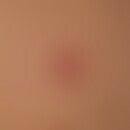Synonym(s)
DefinitionThis section has been translated automatically.
Chemokines, a subgroup of cytokines, are small (size between 8 and 10 kDa), chemotactically active proteins (signal proteins). They are common in all vertebrates, some virus types and bacteria. In humans, about 50 chemokines are currently known. A strongly conserved structural feature of all chemokines is a fixed group of cysteine residues that is stabilized by 1 or 2 disulfide bridges. This key structural position in the molecule is responsible for its fixed 3-dimensional structure.
In the CC chemokines, the cysteines follow each other directly, in the CXC chemokines they are separated (CC = acronym for cysteine-cysteine) by 1, in the CXXXC chemokines by 3 other amino acids. Chemokines are produced and secreted by a variety of immune cells, but also by parenchymatous cells (e.g. hepatocytes, myocytes). They transmit their signals by binding to chemokine receptors via G-proteins. Some chemokines have a pro-inflammatory effect, others have a regulatory effect on the development and homeostasis of tissues.
CCL26 (CC-chemokine ligand 26), also known as eotaxin-3, is a small cytokine of the CC chemokine family, which is mainly involved in inflammatory processes. CCL26 is a ligand for the CCR3 receptor. CCL26 is encoded in humans by the CCL26 gene, which is located on chromosome Chr. 7 q11.2
General informationThis section has been translated automatically.
CCL26 is formed in the heart, lungs and ovaries. Furthermore, the chemokine is formed by interleukin-4 - stimulated endothelial cells. CCL26 binds (like CCL11 and CCL24) to the receptor CCR3 on eosinophilic and basophilic granulocytes and acts chemotactically on eosinophilic and basophilic granulocytes.
OccurrenceThis section has been translated automatically.
Sharifabadi AR et al (2014) were able to demonstrate in patients with pulmonary tuberculosis that the serum levels (produced by Th2 cells) of the chemokines CCL11, CCL24 and CCL26 are elevated compared to control persons.
CCL11, CCL24, and CCL26 are chemokines (family of eotaxins) that act as attractors of eosinophilic granulocytes mainly via the CCR3 receptor.
In patients with allergic bronchial asthma, CCL26 has the strongest chemotactic effect. Blocking the CCR3 receptor with the antibody (CCR3 mAb) leads to a CCL24-induced migration inhibition of eosinophilic granulocytes.
In lesional skin of patients with (extrinsically safe) atopic dermatitis an increased gene expression for the eotaxins CCL11, CCL24, CCL26 can be detected in comparison to healthy persons. Apparently the pathogenetic significance of CCL26 is higher in comparison to CCL24.
LiteratureThis section has been translated automatically.
- Owczarek W et al (2010) Analysis of eotaxin 1/CCL11, eotaxin 2/CCL24 and eotaxin 3/CCL26 expression in lesional and non-lesional skin of patients with atopic dermatitis. Cytokines 50:181-185.
- Provost V et al (2013) CCL26/eotaxin-3 is more effective to induce the migration of eosinophils of asthmatics than CCL11/eotaxin-1 and CCL24/eotaxin-2. J Leukoc Biol 94:213-222.
- Sharifabadi AR et al,(2014) All eotaxins CCL11, CCL24 and CCL26 are increased but to various extents in pulmonary tuberculosis patients. Clin Lab 60:93-97.




